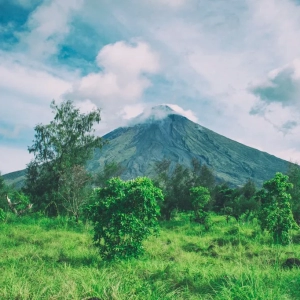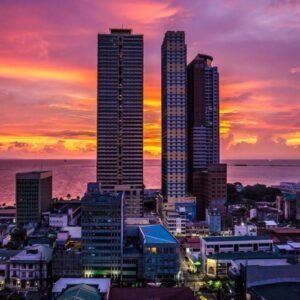Table of Contents
Toggle- Our Philippines Real Estate Guide Gives Insight On The Best Properties To Buy: A Slice of Paradise Awaits
- Popular Areas to Consider
- More Details & Common Property Prices in Manila, Cebu, Davao and Palawan
- What to Know Before Buying Property in the Philippines Real Estate Market
- How to Get Started in Philippines Real Estate
- Understanding the Philippines Real Estate Market: Trends and Opportunities
- Summary on Philippines Real Estate
- Resources To Check Out:
Our Philippines Real Estate Guide Gives Insight On The Best Properties To Buy: A Slice of Paradise Awaits
When you think of the Philippines, you probably picture postcard-worthy beaches, bustling cities, and lush green landscapes. But beyond the vacation brochures lies something even more captivating: the chance to own a piece of this tropical paradise. Whether you’re searching for a cozy home in a quiet province or a sprawling piece of land near the shoreline, the Philippines offers an exciting variety of real estate opportunities. Let’s dive into what makes the country such an incredible place to buy property and how you can make your dream a reality.











When is the Best Time To Buy Real Estate in the Philippines?
Why Invest in the Philippines?
If you’re considering buying property, the Philippines should be on your radar for several compelling reasons.
- A Booming Real Estate Market
The Philippine real estate market has been steadily growing, with increasing demand for residential, commercial, and agricultural properties. Areas like Metro Manila, Cebu, and Davao are bustling hubs with plenty of development, while provinces like Palawan and Siargao are attracting attention for their laid-back charm and tourism potential. - Affordability
Compared to many Western countries, property in the Philippines is relatively affordable. You can find charming homes or decent-sized lots without breaking the bank. Even high-end developments in prime locations often come at a fraction of the cost you’d expect elsewhere. - A Lifestyle Like No Other
Imagine waking up to the sound of waves crashing on a nearby beach or spending weekends exploring hidden waterfalls. The Philippines isn’t just a place to own property—it’s a lifestyle. With its warm weather, friendly locals, and vibrant culture, you’ll quickly feel at home here.
Types of Properties You Can Buy in the Philippines Real Estate Market
When it comes to Philippines Real Estate, there’s something for everyone.
Homes
From modern condos in the heart of Manila to rustic bungalows in provincial towns, there’s no shortage of options.
- City Living: If you thrive in the hustle and bustle, cities like Manila, Cebu, and Davao offer sleek condos, townhouses, and high-end subdivisions. These homes often come with convenient access to malls, schools, and public transportation.
- Provincial Charm: For a slower pace of life, homes in provinces like Batangas or Ilocos offer large lots, lush gardens, and a quieter atmosphere.
Land
Buying land gives you the flexibility to build your dream home, start a business, or simply hold onto it as an investment.
- Beachfront Lots: Perfect for anyone dreaming of a seaside retreat, beachfront properties in Palawan, Siargao, or Zambales are highly sought after.
- Farmland: If you’re interested in farming or eco-tourism, fertile lands in provinces like Laguna and Bukidnon are great options.
- Urban Lots: Building in urban areas like Metro Manila or Cebu ensures proximity to amenities and a solid investment for future resale.
Popular Areas to Consider
With over 7,000 islands, narrowing down where to buy property in the Philippines can be overwhelming. Here’s a closer look at some hotspots:
Metro Manila
The capital region is a hub for business, education, and entertainment. If you’re looking for convenience and accessibility, Manila is your go-to. Neighborhoods like Makati, Bonifacio Global City (BGC), and Ortigas are popular for their modern condos and high-end living.
Cebu
Dubbed the “Queen City of the South,” Cebu offers a balanced mix of city convenience and island vibes. Many expats and locals alike are drawn to its resorts, international schools, and rapidly growing tech industry.
Davao
Known for its safety and eco-conscious developments, Davao is a great place for families. With Mount Apo as a backdrop and Samal Island nearby, you’ll never run out of scenic spots to explore.
Palawan
For nature lovers, Palawan is a dream come true. Beachfront lots and vacation homes here are perfect for those who want to live amidst stunning natural beauty. El Nido and Coron, in particular, are real estate hotspots.
More Details & Common Property Prices in Manila, Cebu, Davao and Palawan
In the following sections below, you will find out the rough prices of buying Philippines real estate in each area.
Metro Manila
The capital region is a hub for business, education, and entertainment. If you’re looking for convenience and accessibility, Manila is your go-to. Neighborhoods like Makati, Bonifacio Global City (BGC), and Ortigas are popular for their modern condos and high-end living.
- Common Prices:
- Condos: In prime areas like Makati and BGC, modern condo units range from ₱7 million to ₱20 million ($125,000 to $350,000 USD) for a one- to two-bedroom unit, with luxury penthouses exceeding ₱50 million ($875,000 USD).
- Townhouses: Townhouses in residential enclaves cost around ₱15 million to ₱40 million ($260,000 to $700,000 USD), depending on size and location.
- Land: Vacant lots in exclusive subdivisions like Forbes Park or Dasmariñas Village can start at ₱400,000 per square meter ($7,000 USD), making land a premium commodity in Metro Manila.
Cebu
Dubbed the “Queen City of the South,” Cebu offers a balanced mix of city convenience and island vibes. Many expats and locals alike are drawn to its resorts, international schools, and rapidly growing tech industry.
- Common Prices:
- Condos: Centrally located condos in Cebu City range from ₱3 million to ₱10 million ($50,000 to $175,000 USD) for a studio or one-bedroom unit, with larger and high-end units priced around ₱12 million to ₱25 million ($210,000 to $440,000 USD).
- Houses: Homes in gated communities like Maria Luisa Estate Park or Banilad can cost between ₱8 million and ₱30 million ($140,000 to $525,000 USD).
- Land: Residential lots in developing areas like Talamban or Mactan Island typically sell for ₱15,000 to ₱50,000 per square meter ($260 to $875 USD), while beachfront land can range higher, starting at ₱25,000 per square meter ($440 USD).
Davao
Known for its safety and eco-conscious developments, Davao is a great place for families. With Mount Apo as a backdrop and Samal Island nearby, you’ll never run out of scenic spots to explore.
- Common Prices:
- Condos: Residential condo units in Davao City are more affordable compared to Metro Manila and Cebu, typically priced between ₱2 million and ₱8 million ($35,000 to $140,000 USD).
- Houses: Single-detached homes in residential developments cost around ₱4 million to ₱12 million ($70,000 to $210,000 USD), depending on proximity to the city center.
- Land: Vacant lots in suburban areas range from ₱10,000 to ₱30,000 per square meter ($175 to $525 USD), while prime beachfront lots on Samal Island can start at ₱20,000 per square meter ($350 USD).
Palawan
For nature lovers, Palawan is a dream come true. Beachfront lots and vacation homes here are perfect for those who want to live amidst stunning natural beauty. El Nido and Coron, in particular, are real estate hotspots.
- Common Prices:
- Houses: Beachfront vacation homes in areas like El Nido or Coron can cost between ₱8 million and ₱25 million ($140,000 to $440,000 USD), while simpler inland homes are available for ₱3 million to ₱10 million ($50,000 to $175,000 USD).
- Land: Prices for beachfront land in Palawan start at around ₱10,000 to ₱50,000 per square meter ($175 to $875 USD), with premium lots in highly desirable locations exceeding ₱70,000 per square meter ($1,225 USD).
- Eco-Friendly Lots: Many buyers are drawn to larger agricultural or eco-friendly lots, which range from ₱1,000 to ₱5,000 per square meter ($17 to $88 USD) depending on location and accessibility.
What to Know Before Buying Property in the Philippines Real Estate Market
Buying property in the Philippines is a straightforward process, but there are a few things to keep in mind:
Foreign Ownership Rules
Foreigners cannot own land in the Philippines but can own condominiums, provided they don’t exceed 40% of the total units in the building. For land, foreigners often partner with a Filipino citizen or lease it long-term. To have the best chance of owning or purchasing Philippines real estate, it is best to find a partner who is willing to help.
Title Verification
Always verify the property’s title to ensure it’s clean and legitimate. The Land Registration Authority (LRA) can help with this.
Budgeting for Extras
Beyond the purchase price, factor in costs like taxes, registration fees, and notary services. These can add up to 5-7% of the property’s value.
Hire a Local Expert
Working with a real estate agent or lawyer familiar with local laws can save you time and stress. They’ll guide you through the paperwork and ensure everything is above board standards.
How to Get Started in Philippines Real Estate
So, how do you go about finding the perfect home or plot of land?
- Set Your Budget
Knowing how much you’re willing to spend narrows your options and helps you focus on what’s realistic. - Identify Your Priorities
Do you want to live near the beach? In a bustling city? Or perhaps somewhere quiet with room to grow vegetables? Having a clear vision will make the search easier. - Research Neighborhoods
Take the time to visit different areas, talk to locals, and get a feel for the community. The Philippines is incredibly diverse, and each province has its own unique vibe. - Explore Listings
Online platforms like Lamudi real estate and Dot Property are great for browsing available homes and land. Local real estate agents can also provide insights into properties that may not be listed online. - Secure Financing
If you’re planning to take out a loan, Philippine banks like BDO and BPI offer mortgage options for locals and some foreigners.
Here’s Further Details to Get Started in Philippines Real Estate
So, you’re ready to dive into the exciting world of real estate in the Philippines! Whether you’re dreaming of a cozy home by the beach, a bustling urban apartment, or a tranquil plot of land to cultivate your own garden, it’s essential to approach the journey thoughtfully. Here’s a friendly guide to help you navigate the process of finding the perfect home or piece of land in this beautiful archipelago.
Set Your Budget
First things first: it’s crucial to set a budget. Knowing how much you’re willing to spend not only narrows down your options but also helps you focus on what’s realistic for your situation. Take a moment to assess your finances and determine how much you can comfortably allocate for your new home. Being clear about your budget will save you time and prevent heartbreak later on.
Identify Your Priorities
Next, think about what you really want in your new space. Do you have your heart set on living near the beach, where you can enjoy sunrises and sunsets every day? Or maybe you envision yourself in a vibrant city surrounded by cafes, shops, and entertainment? Perhaps you’re looking for a peaceful retreat with enough room to grow your own vegetables or even start a small farm. Having a clear vision of your priorities will not only streamline your search but also help you find a place that truly feels like home.
Research Neighborhoods
The Philippines is a treasure trove of diverse communities, each offering something special. Take the time to explore different neighborhoods! You can visit various areas in person, stroll through local markets, and chat with residents to get a feel for the community vibe. Are the locals friendly? Is the area safe and convenient? Understanding the culture and lifestyle of a neighborhood will play a significant role in your happiness once you move in.
Explore Listings
Now that you have your budget and priorities set, it’s time to start exploring listings! Online platforms like Lamudi and Dot Property are wonderful resources for browsing available homes and plots of land. You’ll find everything from luxurious beachfront villas to more modest family homes. Additionally, consider reaching out to local real estate agents who have insider knowledge and can offer insights into properties that might not be publicly listed. They’re often a wealth of information and can help you navigate the market more effectively.
Secure Financing
If you’re thinking about financing your purchase, it’s essential to understand your options. Many Philippine banks, such as BDO and BPI, offer mortgage plans that cater to both locals and, in some cases, foreigners. It’s a good idea to shop around and compare rates, terms, and requirements to find the best fit for your financial situation. Make sure to have all your documents in order and be prepared to ask questions, as this step can often be a little overwhelming.
Remember, the journey to finding your dream home in the Philippines should be enjoyable! Take your time, stay organized, and don’t hesitate to seek help from professionals if you need it. Happy house hunting! 🌴🏡💖
Understanding the Philippines Real Estate Market: Trends and Opportunities
The Philippines real estate market has become a hotspot for local and foreign investors alike. With its vibrant economy, lush landscapes, and favorable demographics, the country presents a myriad of opportunities for growth and return on investment. As the market continues to evolve, understanding its dynamics is crucial for anyone considering investing in property in the Philippines. This article delves into the key trends, challenges, and opportunities within the Philippines real estate sector.
Economic Landscape
The Philippines has shown resilience in its economic growth, with a steady GDP increase over the past few years. Despite challenges brought by global events such as the COVID-19 pandemic, the Filipino economy has rebounded and continues to attract investments. The government has implemented various initiatives to spur economic recovery, including infrastructure development and foreign investment incentives, which positively impact the Philippines real estate market.
One of the most significant factors driving growth in the real estate sector is the demographic advantage. With a young and growing population, coupled with an expanding middle class, there is a rising demand for residential properties. The country’s urban centers, such as Manila, Cebu, and Davao, are witnessing a surge in real estate developments, catering to the increasing need for housing, commercial spaces, and mixed-use developments.
Key Trends in the Philippines Real Estate Market
-
Rise of Vertical Living: As urbanization accelerates, the demand for high-rise condominiums and apartment buildings has increased. This trend is primarily seen in major cities like Metro Manila, where land is scarce and expensive. Developers are now focusing on creating vertical communities that offer affordable living spaces and various amenities to cater to the urban populace.
-
Focus on Sustainable Developments: There is a growing awareness of the importance of sustainability in real estate. Developers are increasingly incorporating green practices in their projects, from energy-efficient designs to the use of renewable materials. Eco-conscious buyers prefer properties that not only offer luxurious amenities but also prioritize environmental friendliness.
-
Growth of the BPO Sector: The Business Process Outsourcing (BPO) sector has thrived in the Philippines, contributing significantly to the demand for office spaces. The rise of remote work and hybrid work models during and after the pandemic has led to a reshaping of office space needs, pushing developers to adapt and offer flexible options.
-
Increased Interest from Foreign Investors: The Philippines real estate market has become an attractive option for foreign investors looking to diversify their portfolios. The liberalization of foreign ownership laws and investment incentives have opened doors for non-residents to invest in real estate, whether for personal use or rental income.
-
Resurgence of Tourism: As the world recovers from the pandemic, the tourism sector in the Philippines is starting to regain momentum. This revival is expected to spur demand for vacation rentals, hotels, and hospitality-related developments. Areas like Boracay, Palawan, and Siargao are already seeing increased interest from investors looking to capitalize on this trend.
-
Digital Transformation in Real Estate: The proliferation of technology is transforming how real estate transactions happen in the Philippines. From virtual tours to online listings, the digitalization of the real estate market has made it easier for buyers and investors to access information, conduct transactions, and connect with sellers.
Challenges Facing the Philippines Real Estate Market
While the prospects of the Philippines real estate market are promising, there are challenges that investors need to be aware of:
-
Regulatory Hurdles: The Philippine real estate industry is subject to various regulations and policies that can impact investment decisions. Foreign investors, in particular, must navigate complex laws related to property ownership and investment.
-
Market Saturation in Some Areas: As more developers rush to meet the increasing demand for housing and commercial spaces, certain urban areas may risk oversaturation. Investors must carefully assess the viability of their chosen locations to avoid being caught in a downturn.
-
Infrastructure Limitations: Although the government is investing heavily in infrastructure development, some areas still suffer from insufficient transportation and public utilities. This can affect property values and the overall attractiveness of a location.
-
Economic Volatility: As with any market, the Philippines real estate sector is influenced by economic factors both domestically and globally. Changes in interest rates, inflation, and external economic conditions can impact property values and demand.
Investment Opportunities
For those looking to tap into the Philippines real estate market, there are several promising investment opportunities:
-
Residential Properties: With the ongoing demand for housing, investing in residential properties, particularly in urban centers, is a solid option. Condominiums and townhouses in highly accessible locations can yield substantial rental income and appreciation over time.
-
Commercial Real Estate: With the BPO sector continuing to grow, commercial properties such as office spaces remain an attractive investment. Locations near business hubs and transport facilities have a higher demand, ensuring a steady flow of tenants.
-
Vacation Rentals and Hospitality: Investors seeking short-term rental opportunities should consider properties in tourist hotspots. The Philippines’ beautiful beaches and natural attractions make it an ideal location for vacation rentals, offering high potential returns.
-
Mixed-Use Developments: Properties that combine residential, commercial, and recreational spaces are becoming increasingly popular. These developments cater to the lifestyle needs of residents, making them desirable for both renters and investors.
Living the Dream
Buying or owning Philippines real estate isn’t just about having a place to live—it’s about embracing a lifestyle full of color, culture, and endless opportunities to explore. Whether you’re watching sunsets on your beachfront porch, farming organic vegetables on your lot, or enjoying the city’s vibrant nightlife, there’s something magical about making this beautiful country your home.
So, are you ready to take the leap? The Philippines awaits, and trust me—it’s a decision you won’t regret. 🏡🌴
Summary on Philippines Real Estate
The Philippines real estate market offers a wealth of opportunities for investors willing to navigate its complexities. With an ever-expanding economy, favorable demographics, and increasing urbanization, the demand for various real estate products remains high. However, potential investors should also be mindful of the challenges that come with investing in real estate in the Philippines. By staying informed and conducting thorough research, investors can position themselves to take advantage of the promising growth of the Philippines real estate market, ensuring a fruitful investment journey.
Overview of the Real Estate Market in the Philippines for Local and Foreign Investors
The real estate market in the Philippines presents promising opportunities for both local and foreign investors, fueled by the country’s robust economic growth and increasing urbanization. The market is characterized by diverse offerings, ranging from affordable housing options to high-end luxury properties, catering to a wide spectrum of buyers.
Location and Price
The most sought-after locations for real estate investment include Metro Manila, Cebu, and Davao, as well as popular tourist destinations like Boracay and Palawan. In Metro Manila, the average property prices can range from PHP 3 million to PHP 15 million (approximately USD 60,000 to USD 300,000), depending on the area and property type. In comparison, properties in Cebu and Davao offer more competitive pricing, with options starting from PHP 1.5 million (around USD 30,000).
Demand and Affordability
There is a steady demand for residential, commercial, and industrial properties, fueled by the growing middle class and the influx of overseas Filipino workers. The affordability of properties varies widely; although some urban areas can be pricey, provincial regions provide more budget-friendly options, attracting buyers interested in expanding or relocating.
Best Locations
Investors looking for prime real estate should consider areas near major business districts, such as Makati, Bonifacio Global City, and Ortigas. These hubs not only offer economic advantages but also provide proximity to essential amenities. Emerging growth areas like Cavite, Rizal, and Bulacan are also gaining popularity due to ongoing infrastructure projects and lower entry costs.
Nearby Amenities
Access to healthcare, safety services, and other essential amenities is crucial for investors. Many key locations are well-served by hospitals, fire brigades, and police stations, ensuring the safety and well-being of residents. Areas like Makati and Quezon City boast reputable hospitals and emergency services, adding to their appeal for long-term investment.
Safety and Prosperity
Overall, the Philippines remains a relatively safe place for real estate investment, though, like any market, it’s essential to conduct thorough research on safety records in specific neighborhoods. Areas experiencing economic growth often indicate higher property appreciation potential. The Philippine government’s ongoing focus on infrastructure development, such as the “Build, Build, Build” program, is a significant factor driving prosperity and investor interest.
New Developments
The real estate sector is witnessing a surge in new developments, with numerous condominium projects, mixed-use developments, and residential communities emerging. These projects often incorporate modern amenities, sustainability practices, and intelligent designs catering to contemporary living standards. Foreign investors, in particular, are drawn to developments within tourist hotspots and areas earmarked for future growth.
In summary, the Philippine real estate market offers a vibrant landscape for investment, rich with potential across various sectors. With its strategic locations, a variety of property types, and continued economic growth, both local and foreign investors can find lucrative opportunities that align with their needs. As always, prospective buyers should conduct thorough due diligence to ensure informed decisions in this dynamic market. Happy investing!
Resources To Check Out:
Homes & Land Expert Resources
Our resources provide greater insight into the Philippines Real Estate sector. You can find more information about buying, selling, leasing or renting properties in the Philippines by clicking here.
Philippine Realty TV
This site provides listings, market news, and insights into the real estate industry in the Philippines.
Property24
Property24 is another comprehensive real estate website where you can find properties for sale and rent across the Philippines.
Realtor.com Philippines
A trusted name in real estate, this website caters to both local and overseas buyers looking to invest in Philippine properties.
Carousell (formerly OLX)
Carousell is a classifieds website where you can find real estate listings among various other categories.
Bangko Sentral ng Pilipinas (BSP) – Government Site: Website: BSP
The Bangko Sentral ng Pilipinas (Central Bank of the Philippines) provides insightful resources and reports on the real estate and housing sector as part of their economic analysis.
Housing and Land Use Regulatory Board (HLURB) – Government Site: Website: HLURB
This government agency oversees land use, housing, and urban development in the Philippines and provides useful information about regulations and standards in real estate.
These links will help you explore the real estate market in the Philippines and access various resources related to property investments. For any other qustions please don’t hesitate to contact us.










Join The Discussion